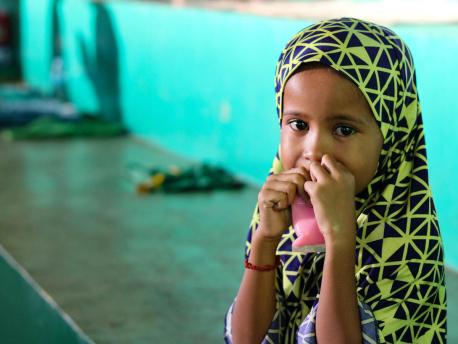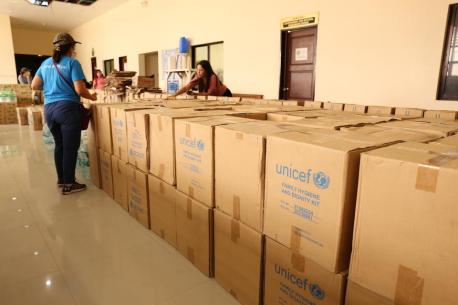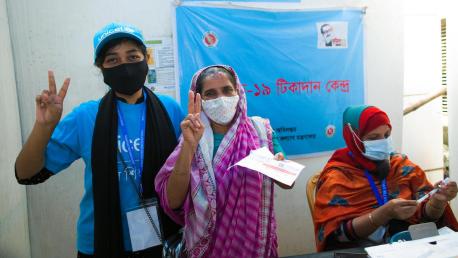
Children from Indigenous Groups in Mindanao Talk About Their Culture
For International Day of the World's Indigenous Peoples, we asked children from different groups in Mandanao, Philippines, to wear their traditional dress and talk about their diverse cultures.

Aizel Lacna, 12, wants to help create traditional Blaan garments and accessories. “I wish all Blaans will be more proud of their tribe. Everyone should be proud of their roots wherever they go,” she said.

“I like how our traditional Iranun dress shines,” said 5-year-old Al-Jesam Abad, who lives in Parang, Maguindanao. “I like its colors, too!”

Sahabudin Manalao, 16, is a Maguindanaon who lives in Lambayong, Sultan Kudarat. “Maguindanaons are known as givers,” he said. “We share food through a kanduli, which is a traditional thanksgiving gathering. I am proud of this practice of ours.”

Naima Mangutara, 10, is an Iranun who lives in Parang, Maguindanao. “My parents taught me how to be hospitable to people from different tribes,” she said.

Jenny Moso, 10, wants to teach other Tboli children to be more loving and proud of their culture. “Tbolis are artistic indigenous people,” she said. “Look at how weaving produces the big images and patterns on T’nalak cloth!”

“Mother teaches us to pray to Allah as Kaagan Muslims,” 6-year-old Farhan Godoy said. “We pray five times a day.”

Renna Ayao, 12, is amazed at how the colorful Blaan garments and accessories are made. “It’s good that Blaan accessories are being sold,” she said. “This helps us promote our culture and make a living at the same time.” Renna wants to learn how to weave tabih, the traditional Blaan handwoven cloth. “This is one way to preserve the traditional art of our group,” she said.

"Kaagan foods and delicacies are my favorite," 4-year-old Jerson Noventa said. "I like pilipit sweets the most!"

“The tandong (head covering) of the Kaagan looks good,” 6-year-old Sofia Pablo said. “I like it when I am wearing it!”

Mark Pagalangan, 8, is a Tagakaolo who lives in Malungon, Saranggani Province. "Our traditional garments have striking colors and intricate designs," he said.

Rosa Capitan, 6, from Malungon, Saangani, wears a balyeg, a necklace made by the Tagakaolo people. “It’s really beautiful,” she said. “I wonder how one needle can finish such a difficult design.”

Carlito Maladian, 9, from Maasim, Sarangani Province, wears a vest made of T’nalak cloth. “I’ve seen how difficult it is to make the T’nalak and how families help and work together to produce this vest. That made me respect the weavers more,” he said.
Carlito wants to be a teacher. “I want to teach Tboli kids to develop ways to protect our cultural treasures,” he said.
UNICEF works in Mindanao to ensure that disadvantaged and vulnerable children, especially those in areas affected by armed conflict, are able to enjoy their rights.
Conflict affects all aspects of a child’s development, including their health, well-being, growth, access to education and ability to play. UNICEF supports children and adolescents in Mindanao so that their voices are heard, and that they are able to contribute to peacebuilding in their communities.
To learn more about UNICEF’s work in the Philippines, visit www.unicef.ph.
To donate to UNICEF programs supporting education, click here.
All photos by Louie Pacardo for UNICEF Philippines.
HOW TO HELP
There are many ways to make a difference
War, famine, poverty, natural disasters — threats to the world's children keep coming. But UNICEF won't stop working to keep children healthy and safe.
UNICEF works in over 190 countries and territories — more places than any other children's organization. UNICEF has the world's largest humanitarian warehouse and, when disaster strikes, can get supplies almost anywhere within 72 hours. Constantly innovating, always advocating for a better world for children, UNICEF works to ensure that every child can grow up healthy, educated, protected and respected.
Would you like to help give all children the opportunity to reach their full potential? There are many ways to get involved.





